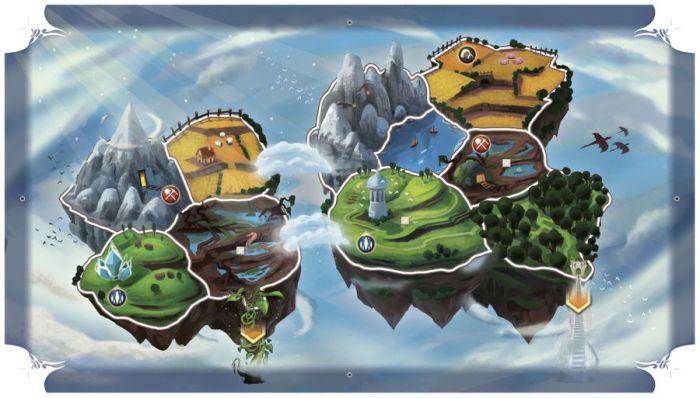Embark on a captivating journey to the extraordinary realm of small world sky islands, isolated havens perched high above the mundane. These ethereal landscapes, adorned with unique flora and fauna, hold a treasure trove of scientific wonders and cultural significance.
Delve into the geological forces that sculpt these sky-high islands, marvel at the remarkable adaptations of their inhabitants, and explore the threats that imperil these fragile ecosystems. Join us as we unravel the mysteries and enchantments of the small world sky island.
Sky Island Formation

Sky islands, also known as tabletop mountains or tepuis, are unique geological formations that rise abruptly from the surrounding landscape. Their distinct flat-topped appearance and isolation make them fascinating natural wonders.
The formation of sky islands is a complex process that involves several geological forces. One of the primary mechanisms is the uplift of large blocks of the Earth’s crust, often caused by tectonic activity. These uplifted blocks are then subjected to erosion, which gradually wears away the softer surrounding rocks, leaving behind the more resistant caprock that forms the flat top of the sky island.
In some cases, sky islands may also be formed by volcanic activity. Lava flows can create isolated plateaus or mesas that, over time, become separated from the main volcanic complex due to erosion.
Flora and Fauna of Sky Islands

Sky islands are often home to unique and diverse flora and fauna due to their isolation and distinct environmental conditions. The table below compares the flora and fauna found on sky islands to those found in surrounding lowland areas:
| Characteristic | Sky Islands | Lowland Areas |
|---|---|---|
| Flora | – High levels of endemism (unique species)Adaptations to high altitudes and nutrient-poor soils
|
– Lower levels of endemismMore diverse range of plant species
|
| Fauna | – High levels of endemism (unique species)Adaptations to isolation and limited resources
|
– Lower levels of endemismMore diverse range of animal species
|
The unique adaptations of plants and animals on sky islands allow them to thrive in the isolated and challenging conditions of these environments. Many species have evolved specialized traits, such as water storage mechanisms, nutrient-absorbing leaves, and reduced body size, to cope with the limited resources and harsh conditions.
Sky islands are recognized as biodiversity hotspots, harboring a significant number of endemic species and contributing to the overall ecological diversity of the planet.
Threats to Sky Islands

Sky islands face various threats that can impact their unique ecosystems. These threats include:
- Habitat loss:Deforestation, mining, and agriculture can lead to the destruction of sky island habitats, reducing the available resources for plants and animals.
- Climate change:Rising temperatures and changes in precipitation patterns can affect the delicate balance of sky island ecosystems, altering the distribution and abundance of species.
- Invasive species:Introduced species, such as non-native plants and animals, can outcompete native species and disrupt the ecological balance of sky islands.
These threats can have severe consequences for sky island ecosystems, leading to the loss of biodiversity, habitat degradation, and disruption of ecological processes.
Exploration and Research on Sky Islands
Sky islands have captured the attention of scientists and explorers for centuries. Here is a timeline showcasing significant explorations and research conducted on sky islands:
- 16th century:Spanish conquistadors encounter sky islands in South America, describing their unique landscapes and biodiversity.
- 18th century:German naturalist Alexander von Humboldt explores sky islands in Venezuela, documenting their diverse flora and fauna.
- 19th century:British naturalist Charles Darwin visits the Galápagos Islands, which are considered sky islands due to their isolation and unique species.
- 20th century:Scientists begin conducting detailed ecological studies on sky islands, uncovering their importance as biodiversity hotspots.
- 21st century:Ongoing research focuses on the conservation and management of sky islands, as well as the study of their unique adaptations and ecological processes.
Research on sky islands has contributed to our understanding of evolution, biodiversity, and the importance of isolated ecosystems. Ongoing efforts aim to protect these unique environments and ensure their conservation for future generations.
Cultural Significance of Sky Islands: Small World Sky Island

Sky islands have held cultural significance in various regions of the world. These isolated formations have often been associated with mythology, folklore, and art:
- South America:Sky islands in the Amazon rainforest are believed to be the home of spirits and deities in indigenous cultures.
- China:Sky islands in the karst landscapes of Guilin are depicted in traditional Chinese paintings and poetry, representing a sense of wonder and isolation.
- Europe:Sky islands in the Alps and Pyrenees have inspired legends of mythical creatures and hidden treasures.
The cultural significance of sky islands reflects the fascination and awe that these unique environments have evoked throughout history. They continue to be a source of inspiration and cultural heritage in many regions of the world.
FAQs
What is the primary geological process responsible for the formation of sky islands?
Erosion and tectonic activity are the key geological processes that shape sky islands.
How do plants and animals adapt to the unique conditions found on sky islands?
Sky island species often exhibit specialized adaptations, such as reduced size, increased water storage capacity, and tolerance to extreme temperatures.
What are the major threats facing sky islands today?
Habitat loss, climate change, and invasive species pose significant threats to the delicate ecosystems of sky islands.
